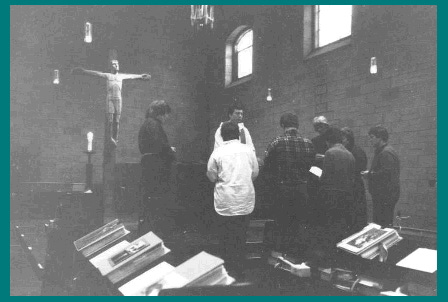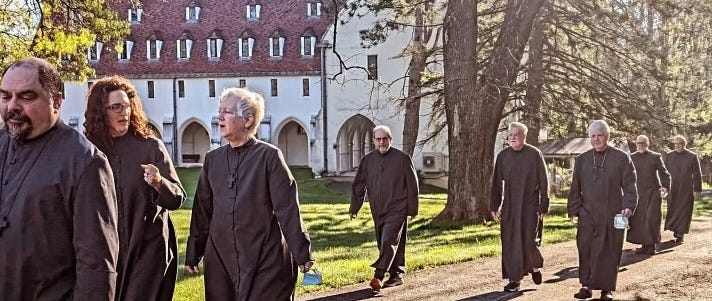The Benedictine Promise
"A binding by which freedom might be found"
On January 8, 1983 on retreat at St. Helena's convent, making a commitment to form the Order of the Ascension
It is the Feast of Saint Benedict. A feast of the Holy Catholic Church and for the Order of the Ascension
The day began with Morning Prayer and an email from Sister Liz, “Happy feast of Saint Benedict.” With a link to A sonnet for St. Benedict. It begins -
You sought to start a simple school of prayer,
A modest, gentle, moderate attempt,
With nothing made too harsh or hard to bear,
Later in the day came The Angelus from Saint Mary the Virgin, Times Square. Reflecting on Saint Benedict and the Benedictines—Ora et labora, an offering of Father John Shirley, the rector of the Church of the Ascension, Staten Island.
I invite us to look to the example of Saint Benedict and the rule of life he wrote, as a potential framework for living our lives—lives that value the balance between prayer, work, rest, and relationships. Perhaps a little more influence from Saint Benedict might assist us in a fractious and frenetic world, and maybe that influence can once again be a beacon of hope, hospitality, compassion, and an instrument of God’s Grace, as it always was, in our own time and place.
Sisters and brothers walking from Morning Prayer to breakfast
The Benedictine Promise
This is a segment of The Benedictine Promise chapter in Fill All Things: The Dynamics of Spirituality in the Parish Church.
Benedictine spirituality is part of our Anglican DNA. It’s the way of the Prayer Book and is embedded in much of the way we function as parish communities. We can make use of it in the work of congregational development: 1) as a way to see and enter into the depth of our own culture as Episcopalians and 2) because it is the spirituality of particular communities that have developed a capacity, over time, to maintain their integrity while renewing themselves in adaptation to the environment. …
Developing a parish culture that is marked by:
Stability – Especially seen in Liturgy, prayer and relationships.
Obedience – Seen in our openness to listen, and respond to, one another, our bishop and the larger church.
Conversion of Life – Out of our life of stability or obedience we see and act on new challenges and opportunities for mission and building up the Body of Christ. …
The Benedictine tradition includes a promise of stability, obedience, and conversion of life. That "promise" is not only a commitment made in community, it is a lens into the inner life and dynamics of a community. We have seen the health of a parish that is grounded in a rich and complex prayer life; in which there is deep listening, both interpersonal and in communal discernment; and where there is an openness of minds and hearts to the future that God offers. We have also seen parishes that seem to express a shadow side - where stability is turned to frozenness and obsession with parish traditions; where obedience has either become legalism or has no hold at all; where conversion of life is the cover for self-absorption in which change is driven by sentimentality or political ideology. We know of parishes where there is an obsession with change and others with maintaining traditions. …
The work that’s been done on organizational culture can be a very useful tool in relation to Benedictine spirituality. In looking at this I’m relying on the work of Edgar Schein8 and other theorists and practitioners in the field. Organizational culture is a web of shared ways of being and working, stated values and deep underlying assumptions about the nature of things. Within the organization this defines “reality” for people. And as part of that reality, culture offers a sense of identity and meaning; and the ground upon which the organization can have some sense of integration among its various elements. Benedict’s Rule and the tradition of Benedictine communities provide all the essential aspects of an organizational culture.
In what follows I’ll offer a variety of specific ideas about how to shape a parish culture grounded in Benedictine spirituality. Let me begin with the broad strokes. What shapes the organizational culture of a parish church? There are the more obvious things—the liturgical space, its beauty and functionality; the way the liturgy is done and the degree and form of congregational participation; the feel of and what is available in the rest of the parish property; how meeting rooms are arranged and what resources they provide; the stories that get told and retold; formal statements of belief and values; and the way the decision-making is structured. The greatest impact on shaping the parish’s culture is in what leaders do. How they deal with crisis and other critical situations, how they stack the resources of the parish in one direction or another; and what they pay attention to, measure and reward. The leader’s efforts at training, education and coaching are also central parts of forming the parish culture. …
Healthy Stability
Most organizational life cycle models suggest a development that moves from creation through formation to a place of maturity or stability. The model I frequently use differentiates between healthy stability and static stability. Healthy stability is maintained by addressing the tasks of parish formation in a spirit of, and with the behaviors of, obedience and conversion of life. The parish’s stability doesn’t come about by pursuing stability in itself but by being a listening community and engaging the issues and people that invite us consider when we need to let go of loved ways and secure places.
In times of healthy maturity, some people will yearn for those times of institutional formation with the adventure of dreams and significant work to accomplish. Some will so miss the excitement of institution and community creation that they will avoid the work needed during the healthy stability phase. Others simply get anxious during this phase because they don’t know how to live in it and may lack the associated competencies. They may be tempted to focus on institutional and administrative goals. The work of membership growth, building projects, special attention to financial management, and great service ministries all need to be addressed at some points in a parish’s life. At other times these projects substitute busyness and a desire for institutional success for the ongoing and primary work of Christian formation.
The primary task is the formation of the People of God at all stages of their life. It is always a needed ministry but it is all too often done as though it were simply one program among other programs. There is a kind of half-life that is generated in churches that stay caught up in some institutional scheme. There are clergy and parishes that find themselves always seeking a new challenge in a new project, a project defined by a sense of numerical or physical accomplishment. Instead, choose to make the liturgy an experience of delight and enchantment; choose to create an adult foundations program that equips people with a capacity for spiritual discipline and ways of thinking that rise from what is eternal. Choose to have many opportunities in which those who are Christ’s own come to know themselves and each other as people of curiosity and discernment, of courage and perseverance, of joy and wonder, and lovers of God.
Static stability is characterized by an inability to effectively address being on a plateau in membership or spiritual life; seeing planning methods as a way to control the future; fussing over small things; not responding to new opportunities; losing a sense of vision and purpose; and an identity that is increasingly focused on the past and can seem bland.
If that condition isn’t turned around the parish will usually slide into decline characterized by denying that we are really in trouble; avoiding the needed conversations and resources to have the conversation; increased levels of stress; a nostalgic climate; low or fragmented energy; and a “fear-blame” cycle in which people begin to search for someone to blame (the priest, the diocese, the people who left for another parish, the change in the neighborhood’s demographics). Leaders may step away from accepting responsibility. Or new leaders may emerge with a narcissistic orientation in which they are all too ready to take control and “save” the parish.
The ministry of parish development frequently involves helping churches move out of static and declining lives and engage the tasks of formation in a manner that fits the here and now life of the parish. But it also is about how to serve the many parishes in a state of health stability. How do we help them stay healthy and faithful?
The work of formation whether from a place of decline or of health includes shaping a new vision or sense of direction and managing the polarity of maintaining parish identity and integrity while making adaptations that serve survival and mission. Parish formation embraces the task of grounding the parish in its organic reality as a microcosm of the Holy Catholic Church, attracting new members, developing new leaders, and nurturing a deeper inner life among individuals and the whole parish community. This work is always with us.
A stable and healthy parish can find itself no longer hoping for a new and better life. It can stop being attentive to the movement of the Spirit. The fact of its health and faithfulness can undermine its continued health and faithfulness. We can lose touch with Newman’s, “To live is to change, and to be perfect is to have changed often.” How does the healthy, mature parish do just that? How do we change often and be stable?
In most cases the starting place is among the current members. Leaders and consultants can provide an environment and processes that help members identify and give voice to their deeper hopes and longings. This work takes some care. It’s easy for traditional exercises to generate either an image of the new that is really just the current way repackaged or a radical and utopian dream that brings more judgment than hope. As useful as mutual ministry reviews and leadership retreats can be they are rarely tools that bring a parish closer to its depth and uniqueness. The longings and energy of the People of God need a gentle space in which they can emerge. We might try more of these kinds of things: (Enough - to learn what those things are, buy the book - Fill All Things: The Dynamics of Spirituality in the Parish Church.)
This abides,
Brother Robert, OA
Related resources
Parish Cultural Density - “David Brooks wrote this about cultural density: “Some organizations are thick, and some are thin. Some leave a mark on you, and some you pass through with scarcely a memory.” [28] He goes on to write, “A thick institution is not one that people use instrumentally, to get a degree or to earn a salary. A thick organization becomes part of a person’s identity and engages the whole person: head, hands, heart and soul.”
Assessing with the Benedictine Promise - links to several assessment processes.
Subcultures in the parish - Parishes need ways of effectively and faithfully managing the relationship between the body as a whole and necessary and important subcultures.
Troubled Parish Cultures - An Inward Focus, Short Term Focus, and more
The Order of the Ascension - an overview of OA
This lovely, clunky, untidy vehicle of the Eternal Charity - Sister Michelle’s homily from the 2025 OA retreat
Parish Life Cycle - there is a chapter on the life cycle in An Energy Not Its Own: Three cycles of parish life and the purposes of the parish church




